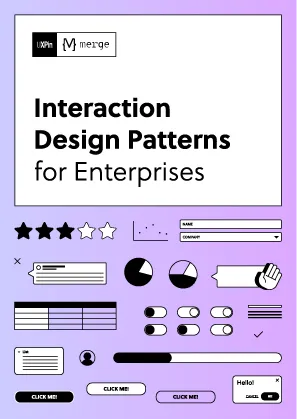Did you know over 1 billion people live with disabilities? Designing accessible prototypes ensures your digital products work for everyone.
Here’s a quick guide to creating accessible interactive prototypes:
- Follow WCAG Guidelines: Ensure designs are perceivable, operable, understandable, and robust.
- Use Accessibility Tools: Platforms like UXPin, Figma, and Sketch offer built-in accessibility features.
- Address Common Issues: Fix low contrast, add alt text, enable keyboard navigation, and enlarge touch targets.
- Test Accessibility: Use tools like WAVE and Lighthouse, and gather feedback from real users with disabilities.
WCAG for beginners – What are the Web Content Accessibility Guidelines?
Accessibility Standards and Guidelines
When creating interactive prototypes, it’s crucial to follow established standards like the Web Content Accessibility Guidelines (WCAG). These guidelines help ensure your prototypes are usable for people with different needs and abilities.
WCAG Guidelines for Prototypes
WCAG is based on four core principles, often referred to as POUR:
- Perceivable: Make content visible and provide alternatives like text descriptions and sufficient contrast.
- Operable: Ensure all features can be used with a keyboard and that interactive elements are straightforward to navigate.
- Understandable: Design clear navigation and minimize user errors with predictable layouts.
- Robust: Make sure your content works seamlessly with assistive tools like screen readers.
Common Accessibility Issues
Here are some frequent problems and how to address them:
| Problem | Solution |
|---|---|
| Low Color Contrast: Text may be hard to read for users with visual impairments | Use tools like WebAIM‘s contrast checker to meet the 4.5:1 ratio |
| Lack of Keyboard Navigation: Excludes users who rely on keyboards | Ensure logical navigation with the Tab key |
| Missing Alt Text: Screen readers can’t interpret images | Add descriptive alt text for all visuals |
| Small Touch Targets: Hard for users with motor difficulties to interact | Design buttons and elements at least 24×24 pixels in size |
"Keyboard accessibility is one of the most important principles of Web accessibility, because no matter how radically different those devices are in appearance from standard keyboards."
To avoid these issues, start accessibility testing early in your design process. Tools like WAVE and AChecker can identify potential barriers before they become ingrained in your prototype. Testing with real users who depend on assistive technologies also provides valuable insights for improving accessibility.
Tools and Setup for Accessible Prototypes
Modern prototyping platforms make it easier to design with accessibility in mind, thanks to their built-in features.
Choosing the Best Tools
When picking a prototyping tool, look for ones that prioritize accessibility. For example, UXPin includes a Contrast Analyzer and Color Blindness Simulator, allowing designers to focus on inclusivity right from the start.
Here’s a quick comparison of popular prototyping tools and their accessibility-focused features:
| Tool | Key Accessibility Features | Best For |
|---|---|---|
| UXPin | Contrast Analyzer, Color Blindness Simulator, WCAG checker | High-fidelity interactive prototypes |
| Figma | Auto-layout, Component libraries, Smart Animate | Collaborative design workflows |
| Sketch | Vector editing, Symbols library, Accessibility plugins | MacOS users, Design system creation |
Setting Up Your Tools
1. Turn On Accessibility Features
In UXPin, activate the Contrast Analyzer to ensure text contrast aligns with WCAG standards (4.5:1 for normal text, 3:1 for large text).
2. Use Pre-Built Components
Leverage accessible components from libraries. UXPin’s React libraries, like MUI, Tailwind UI, and Ant Design, include ARIA support and built-in accessibility.
3. Install Testing Plugins
For Figma users, adding the "A11y – Color Contrast Checker" plugin helps validate color combinations throughout the design process.
With your tools ready, focus on building a design system that promotes accessibility and consistency across all prototypes.
Building an Accessible Design System
Following WCAG’s Perceivable and Understandable principles, start by defining these key elements:
Color Palette Setup
- Ensure your color system meets WCAG contrast ratios (at least 4.5:1 for text).
- Provide alternative palettes to accommodate users with color blindness.
- Set a minimum font size of 16px for body text and establish clear heading hierarchies.
- Define line heights and letter spacing to improve readability.
"Just because there’s a bare minimum doesn’t mean we should strive for that. Designing accessibly serves all users better."
sbb-itb-f6354c6
Building Accessible Interactive Elements
Interactive elements are a key part of prototypes, and making them accessible ensures that your designs work for everyone. Here’s a closer look at three key interaction methods: keyboard navigation, screen reader support, and touch interfaces.
Keyboard Controls
Keyboard navigation is essential for users who rely on keyboards, such as those with motor impairments or those who simply prefer it.
- Focus Indicators: Make sure interactive elements have visible focus indicators, like a 2px outline. In UXPin, you can adjust these to meet WCAG guidelines.
- Navigation Flow: Ensure the tab order mirrors the visual layout and allows users to exit components smoothly using the keyboard.
| Key Command | Function |
|---|---|
| Tab/Shift+Tab | Navigate between interactive elements |
| Arrow Keys | Move within composite controls |
| Enter/Space | Activate buttons and links |
| Esc | Exit modals or expanded menus |
Keyboard navigation ensures users can interact with content, but screen reader compatibility is just as important for accessibility.
Screen Reader Compatibility
Screen readers depend on proper semantic structure and clear descriptions to interpret your prototype effectively.
- ARIA Labels: Add ARIA labels to clarify interactive elements. For example:
<button aria-label="Submit form">Continue</button>. - Content Structure: Use semantic HTML and logical heading levels (H1-H6) to help screen readers guide users through the content.
Touch interfaces, another critical area, require thoughtful design to accommodate different user needs.
Touch and Visual Elements
For touch interactions, follow WCAG’s minimum touch target size of 24x24px, though 44x44px is often better for usability.
- Visual Feedback: Provide clear feedback for interactions, like hover states with a 3:1 contrast ratio or touch animations under 400ms.
"A clear visual indication of keyboard focus is an important usability aid for all keyboard users, especially those with low vision".
"If focus is moved to a component of the page via the keyboard, then that focus should be able to exit that component also using the keyboard".
Testing Accessibility Features
Testing ensures your prototype works well for everyone, meeting both technical standards and user needs. This involves using automated tools, manual checks, and direct feedback from users to identify and fix accessibility problems.
Running Accessibility Tests
Automated tools like WAVE and Lighthouse are great for spotting issues such as missing ARIA labels or poor keyboard navigation. They provide valuable insights into how well your prototype aligns with accessibility guidelines.
| Testing Tool | Purpose | Key Features Checked |
|---|---|---|
| WAVE | Analyzes structure | ARIA labels, semantic HTML |
| Lighthouse | Checks performance | Color contrast, keyboard navigation |
| Screen readers | Tests content usability | Text alternatives, heading structure |
While these tools are helpful, combining them with real user testing ensures your prototype accommodates a wide range of needs.
Testing with Target Users
Invite users with different accessibility requirements to test your prototype. This helps uncover barriers in navigation and interaction:
- Screen reader users can evaluate content hierarchy and interactive elements.
- Keyboard-only users help identify navigation challenges.
- Users with visual impairments (e.g., color blindness or those using screen magnifiers) can assess visual accessibility.
"A clear visual indication of keyboard focus is an important usability aid for all keyboard users, especially those with low vision".
The feedback from these sessions is invaluable for addressing gaps and improving accessibility.
Making Improvements
Address the most pressing issues highlighted during testing:
- Adjust keyboard navigation paths based on user input.
- Improve ARIA labels and ensure a clear structure for screen readers.
- Use tools like UXPin to validate changes and ensure progress.
Accessibility testing is not a one-time task. Regular checks throughout the design process make it easier to catch and fix issues early.
Conclusion
Why Accessible Design Matters
Accessible design ensures digital interfaces work for everyone, not just individuals with disabilities. By focusing on accessibility during the design process, teams create solutions that are more user-friendly for all.
Prototyping tools play a key role here. They allow designers to address accessibility issues early, especially for complex interactive elements that require multiple input methods.
"WCAG is the floor, not the ceiling"
Steps to Get Started
Ready to make accessibility part of your prototyping workflow? Here’s a quick guide:
| Action Step | Key Focus | Outcome |
|---|---|---|
| Configure Tools | Enable accessibility features in your tools | Identify barriers early |
| Build Accessible Components | Use pre-tested WCAG-compliant elements | Ensure consistency and inclusivity |
| Test with Users | Get feedback from diverse user groups | Improve designs continuously |
Start by learning how your users interact with your prototypes. Modern devices support various input methods – touch, keyboard, voice commands – so your designs need to accommodate them all. Following these steps ensures your prototypes meet WCAG’s core principles: perceivable, operable, understandable, and robust.

